Nursing Regulation Report: Regulatory Requirements and Implementation
VerifiedAdded on 2020/03/16
|9
|1666
|33
Report
AI Summary
This report provides a detailed analysis of nursing regulation, focusing on the crucial aspects of approval and accreditation within nursing education. It emphasizes the significance of regulatory requirements, proposing that inexperienced nurses should not be allowed to provide care to critically ill patients, those in palliative care, pediatric units, maternity units, emergency departments, and intensive care units. The report highlights the need for comprehensive training and experience, citing the potential for medical errors due to a lack of experience. It also examines the implementation of these regulations, including the role of senior healthcare professionals in training and mentoring novice nurses. Furthermore, the report reviews legal and regulatory requirements, including certification, educational qualifications, and the importance of integrity and accountability in nursing practice. It also discusses the impact of federal regulations and QSEN competencies to improve patient care.
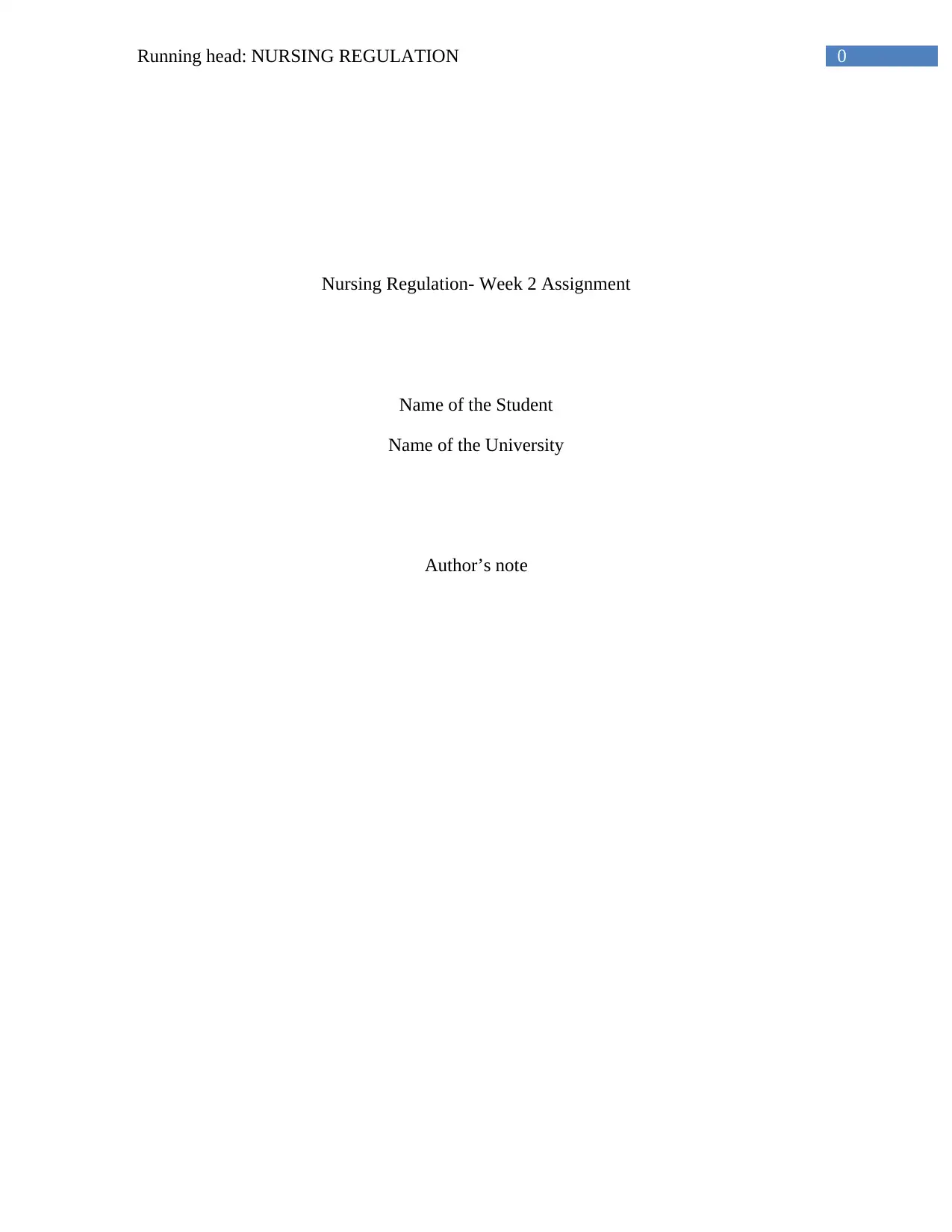
0Running head: NURSING REGULATION
Nursing Regulation- Week 2 Assignment
Name of the Student
Name of the University
Author’s note
Nursing Regulation- Week 2 Assignment
Name of the Student
Name of the University
Author’s note
Paraphrase This Document
Need a fresh take? Get an instant paraphrase of this document with our AI Paraphraser
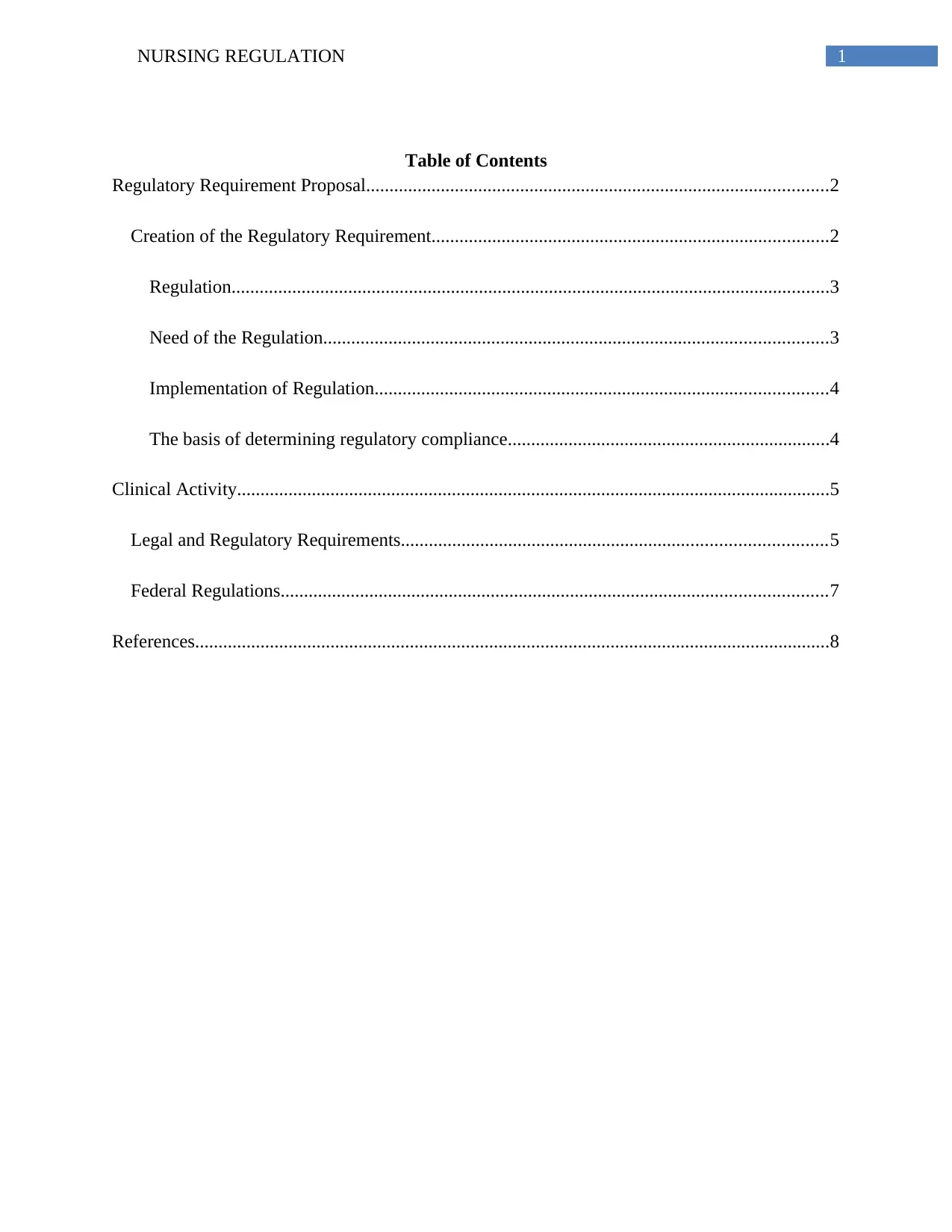
1NURSING REGULATION
Table of Contents
Regulatory Requirement Proposal...................................................................................................2
Creation of the Regulatory Requirement.....................................................................................2
Regulation................................................................................................................................3
Need of the Regulation............................................................................................................3
Implementation of Regulation.................................................................................................4
The basis of determining regulatory compliance.....................................................................4
Clinical Activity...............................................................................................................................5
Legal and Regulatory Requirements...........................................................................................5
Federal Regulations.....................................................................................................................7
References........................................................................................................................................8
Table of Contents
Regulatory Requirement Proposal...................................................................................................2
Creation of the Regulatory Requirement.....................................................................................2
Regulation................................................................................................................................3
Need of the Regulation............................................................................................................3
Implementation of Regulation.................................................................................................4
The basis of determining regulatory compliance.....................................................................4
Clinical Activity...............................................................................................................................5
Legal and Regulatory Requirements...........................................................................................5
Federal Regulations.....................................................................................................................7
References........................................................................................................................................8
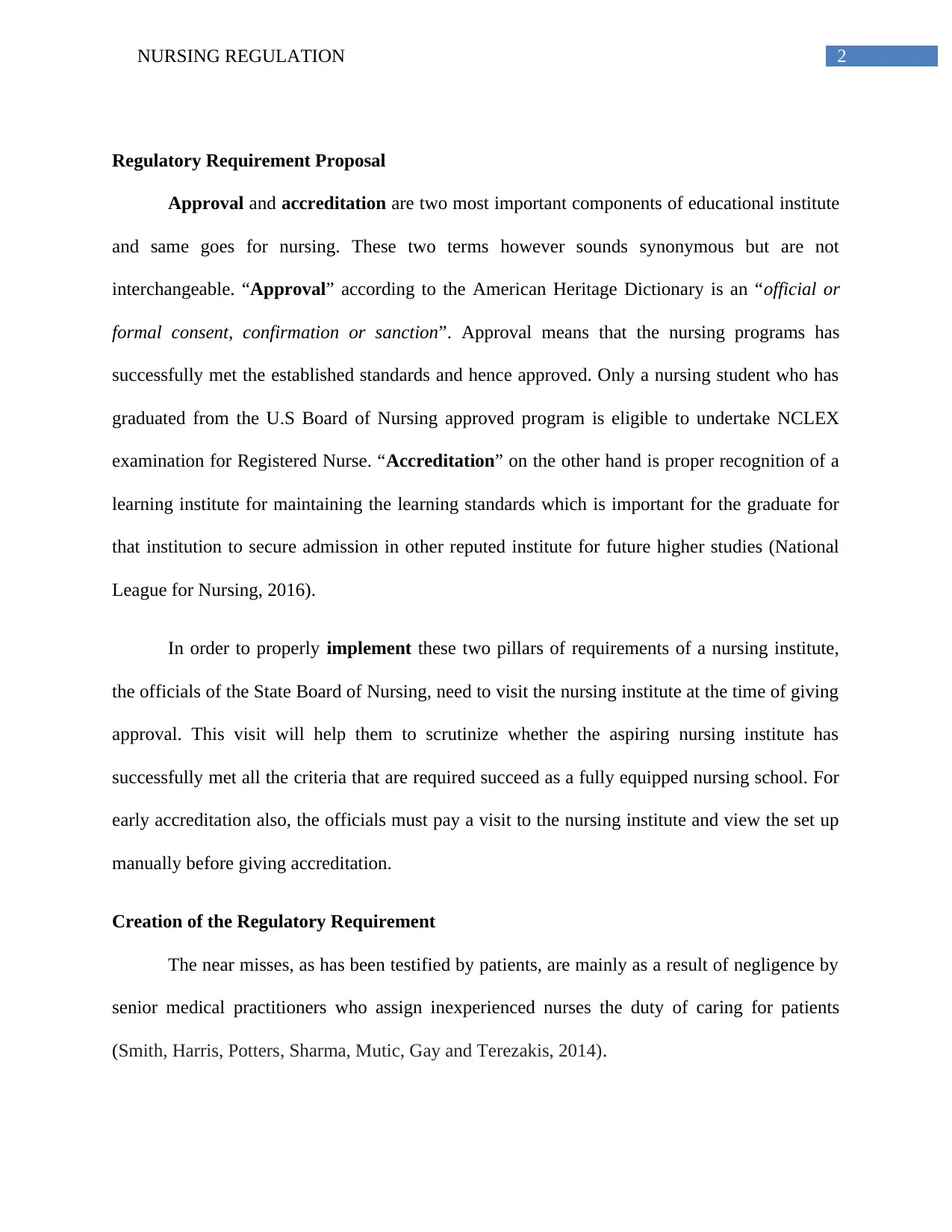
2NURSING REGULATION
Regulatory Requirement Proposal
Approval and accreditation are two most important components of educational institute
and same goes for nursing. These two terms however sounds synonymous but are not
interchangeable. “Approval” according to the American Heritage Dictionary is an “official or
formal consent, confirmation or sanction”. Approval means that the nursing programs has
successfully met the established standards and hence approved. Only a nursing student who has
graduated from the U.S Board of Nursing approved program is eligible to undertake NCLEX
examination for Registered Nurse. “Accreditation” on the other hand is proper recognition of a
learning institute for maintaining the learning standards which is important for the graduate for
that institution to secure admission in other reputed institute for future higher studies (National
League for Nursing, 2016).
In order to properly implement these two pillars of requirements of a nursing institute,
the officials of the State Board of Nursing, need to visit the nursing institute at the time of giving
approval. This visit will help them to scrutinize whether the aspiring nursing institute has
successfully met all the criteria that are required succeed as a fully equipped nursing school. For
early accreditation also, the officials must pay a visit to the nursing institute and view the set up
manually before giving accreditation.
Creation of the Regulatory Requirement
The near misses, as has been testified by patients, are mainly as a result of negligence by
senior medical practitioners who assign inexperienced nurses the duty of caring for patients
(Smith, Harris, Potters, Sharma, Mutic, Gay and Terezakis, 2014).
Regulatory Requirement Proposal
Approval and accreditation are two most important components of educational institute
and same goes for nursing. These two terms however sounds synonymous but are not
interchangeable. “Approval” according to the American Heritage Dictionary is an “official or
formal consent, confirmation or sanction”. Approval means that the nursing programs has
successfully met the established standards and hence approved. Only a nursing student who has
graduated from the U.S Board of Nursing approved program is eligible to undertake NCLEX
examination for Registered Nurse. “Accreditation” on the other hand is proper recognition of a
learning institute for maintaining the learning standards which is important for the graduate for
that institution to secure admission in other reputed institute for future higher studies (National
League for Nursing, 2016).
In order to properly implement these two pillars of requirements of a nursing institute,
the officials of the State Board of Nursing, need to visit the nursing institute at the time of giving
approval. This visit will help them to scrutinize whether the aspiring nursing institute has
successfully met all the criteria that are required succeed as a fully equipped nursing school. For
early accreditation also, the officials must pay a visit to the nursing institute and view the set up
manually before giving accreditation.
Creation of the Regulatory Requirement
The near misses, as has been testified by patients, are mainly as a result of negligence by
senior medical practitioners who assign inexperienced nurses the duty of caring for patients
(Smith, Harris, Potters, Sharma, Mutic, Gay and Terezakis, 2014).
⊘ This is a preview!⊘
Do you want full access?
Subscribe today to unlock all pages.

Trusted by 1+ million students worldwide
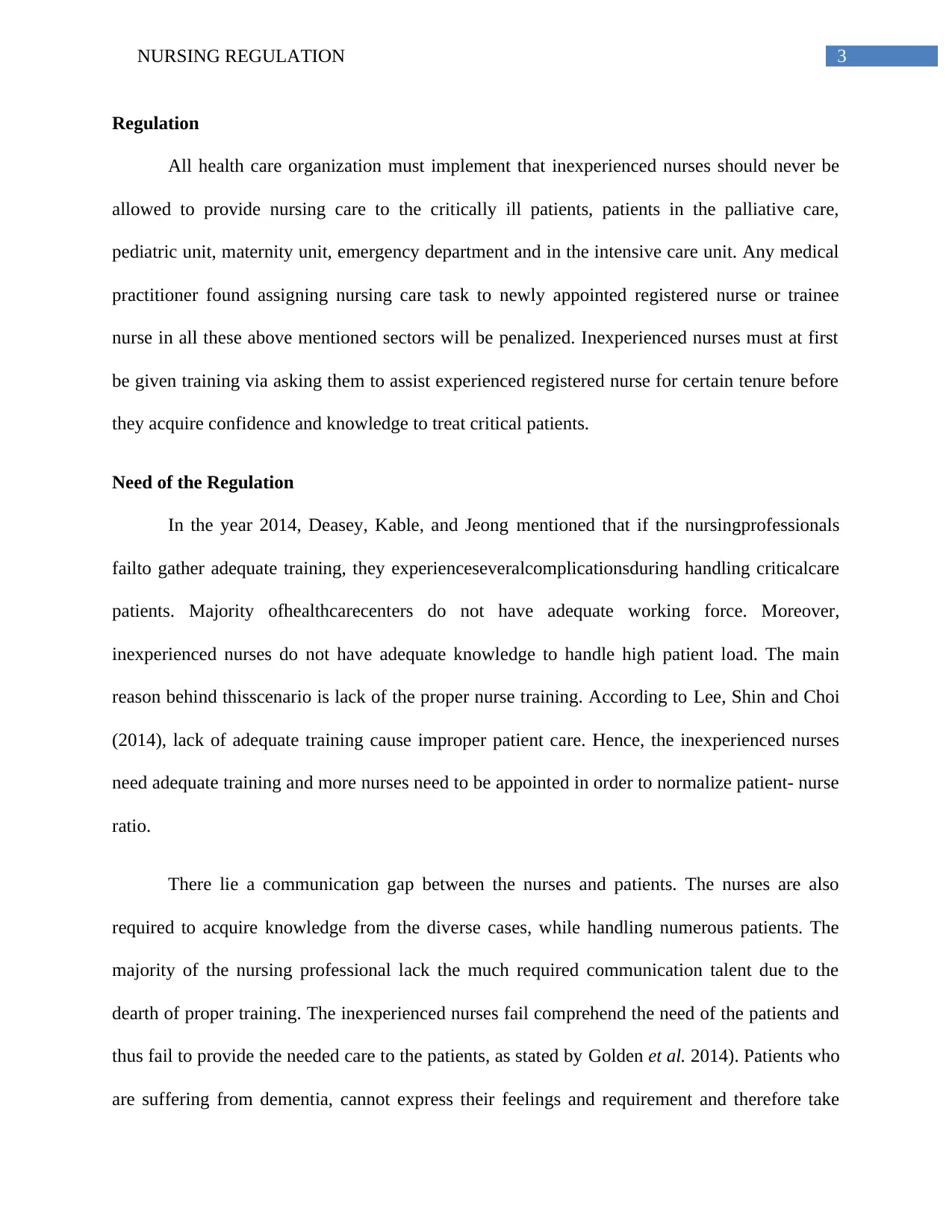
3NURSING REGULATION
Regulation
All health care organization must implement that inexperienced nurses should never be
allowed to provide nursing care to the critically ill patients, patients in the palliative care,
pediatric unit, maternity unit, emergency department and in the intensive care unit. Any medical
practitioner found assigning nursing care task to newly appointed registered nurse or trainee
nurse in all these above mentioned sectors will be penalized. Inexperienced nurses must at first
be given training via asking them to assist experienced registered nurse for certain tenure before
they acquire confidence and knowledge to treat critical patients.
Need of the Regulation
In the year 2014, Deasey, Kable, and Jeong mentioned that if the nursingprofessionals
failto gather adequate training, they experienceseveralcomplicationsduring handling criticalcare
patients. Majority ofhealthcarecenters do not have adequate working force. Moreover,
inexperienced nurses do not have adequate knowledge to handle high patient load. The main
reason behind thisscenario is lack of the proper nurse training. According to Lee, Shin and Choi
(2014), lack of adequate training cause improper patient care. Hence, the inexperienced nurses
need adequate training and more nurses need to be appointed in order to normalize patient- nurse
ratio.
There lie a communication gap between the nurses and patients. The nurses are also
required to acquire knowledge from the diverse cases, while handling numerous patients. The
majority of the nursing professional lack the much required communication talent due to the
dearth of proper training. The inexperienced nurses fail comprehend the need of the patients and
thus fail to provide the needed care to the patients, as stated by Golden et al. 2014). Patients who
are suffering from dementia, cannot express their feelings and requirement and therefore take
Regulation
All health care organization must implement that inexperienced nurses should never be
allowed to provide nursing care to the critically ill patients, patients in the palliative care,
pediatric unit, maternity unit, emergency department and in the intensive care unit. Any medical
practitioner found assigning nursing care task to newly appointed registered nurse or trainee
nurse in all these above mentioned sectors will be penalized. Inexperienced nurses must at first
be given training via asking them to assist experienced registered nurse for certain tenure before
they acquire confidence and knowledge to treat critical patients.
Need of the Regulation
In the year 2014, Deasey, Kable, and Jeong mentioned that if the nursingprofessionals
failto gather adequate training, they experienceseveralcomplicationsduring handling criticalcare
patients. Majority ofhealthcarecenters do not have adequate working force. Moreover,
inexperienced nurses do not have adequate knowledge to handle high patient load. The main
reason behind thisscenario is lack of the proper nurse training. According to Lee, Shin and Choi
(2014), lack of adequate training cause improper patient care. Hence, the inexperienced nurses
need adequate training and more nurses need to be appointed in order to normalize patient- nurse
ratio.
There lie a communication gap between the nurses and patients. The nurses are also
required to acquire knowledge from the diverse cases, while handling numerous patients. The
majority of the nursing professional lack the much required communication talent due to the
dearth of proper training. The inexperienced nurses fail comprehend the need of the patients and
thus fail to provide the needed care to the patients, as stated by Golden et al. 2014). Patients who
are suffering from dementia, cannot express their feelings and requirement and therefore take
Paraphrase This Document
Need a fresh take? Get an instant paraphrase of this document with our AI Paraphraser
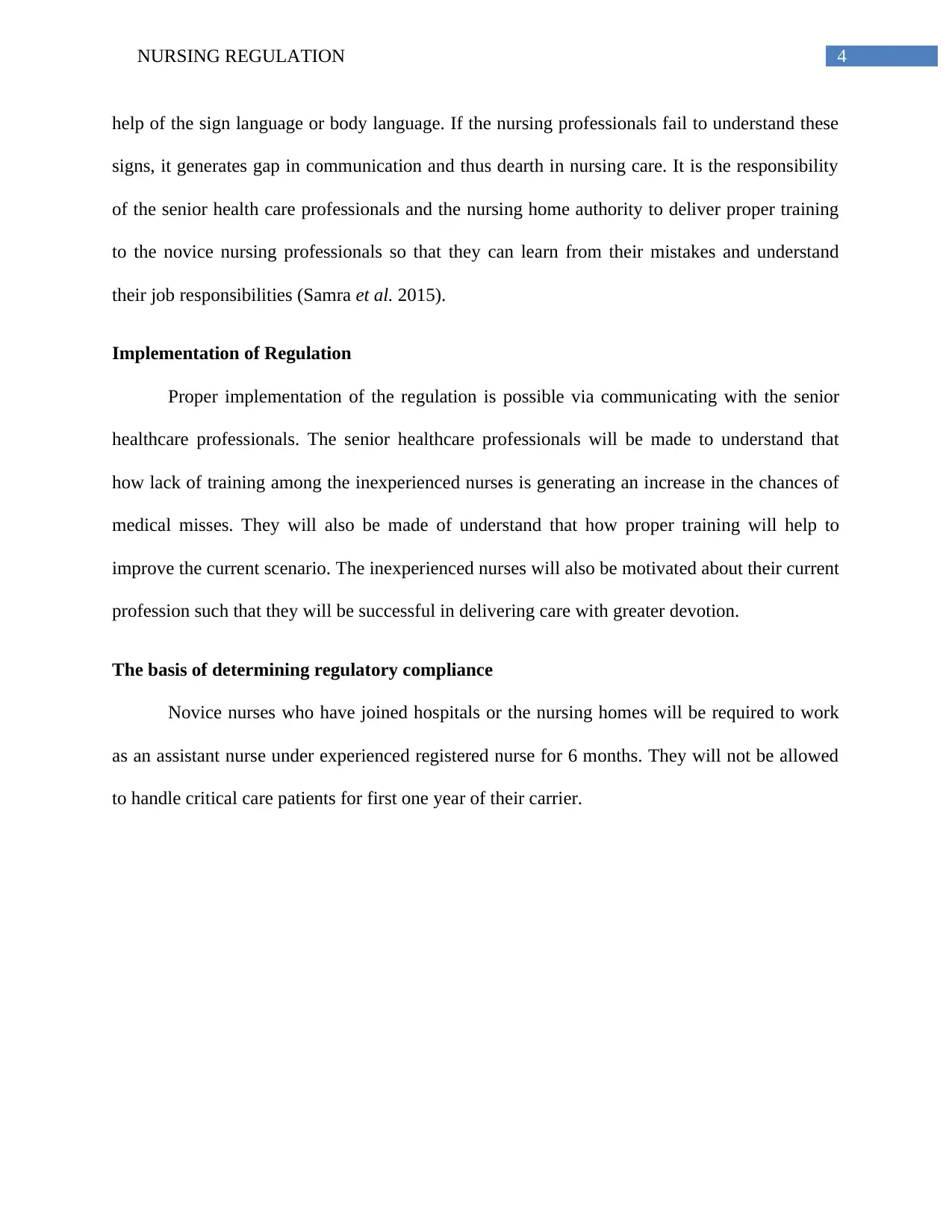
4NURSING REGULATION
help of the sign language or body language. If the nursing professionals fail to understand these
signs, it generates gap in communication and thus dearth in nursing care. It is the responsibility
of the senior health care professionals and the nursing home authority to deliver proper training
to the novice nursing professionals so that they can learn from their mistakes and understand
their job responsibilities (Samra et al. 2015).
Implementation of Regulation
Proper implementation of the regulation is possible via communicating with the senior
healthcare professionals. The senior healthcare professionals will be made to understand that
how lack of training among the inexperienced nurses is generating an increase in the chances of
medical misses. They will also be made of understand that how proper training will help to
improve the current scenario. The inexperienced nurses will also be motivated about their current
profession such that they will be successful in delivering care with greater devotion.
The basis of determining regulatory compliance
Novice nurses who have joined hospitals or the nursing homes will be required to work
as an assistant nurse under experienced registered nurse for 6 months. They will not be allowed
to handle critical care patients for first one year of their carrier.
help of the sign language or body language. If the nursing professionals fail to understand these
signs, it generates gap in communication and thus dearth in nursing care. It is the responsibility
of the senior health care professionals and the nursing home authority to deliver proper training
to the novice nursing professionals so that they can learn from their mistakes and understand
their job responsibilities (Samra et al. 2015).
Implementation of Regulation
Proper implementation of the regulation is possible via communicating with the senior
healthcare professionals. The senior healthcare professionals will be made to understand that
how lack of training among the inexperienced nurses is generating an increase in the chances of
medical misses. They will also be made of understand that how proper training will help to
improve the current scenario. The inexperienced nurses will also be motivated about their current
profession such that they will be successful in delivering care with greater devotion.
The basis of determining regulatory compliance
Novice nurses who have joined hospitals or the nursing homes will be required to work
as an assistant nurse under experienced registered nurse for 6 months. They will not be allowed
to handle critical care patients for first one year of their carrier.
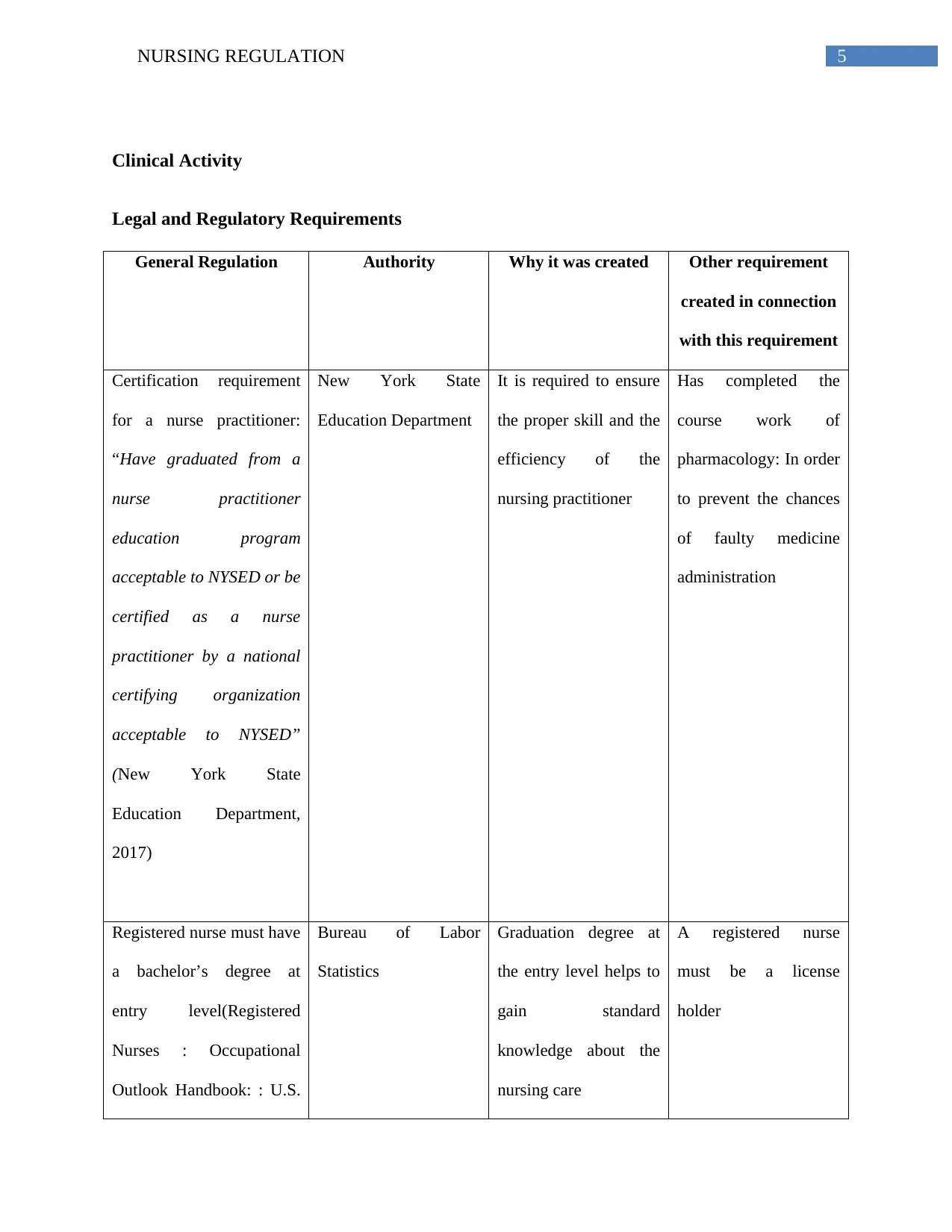
5NURSING REGULATION
Clinical Activity
Legal and Regulatory Requirements
General Regulation Authority Why it was created Other requirement
created in connection
with this requirement
Certification requirement
for a nurse practitioner:
“Have graduated from a
nurse practitioner
education program
acceptable to NYSED or be
certified as a nurse
practitioner by a national
certifying organization
acceptable to NYSED”
(New York State
Education Department,
2017)
New York State
Education Department
It is required to ensure
the proper skill and the
efficiency of the
nursing practitioner
Has completed the
course work of
pharmacology: In order
to prevent the chances
of faulty medicine
administration
Registered nurse must have
a bachelor’s degree at
entry level(Registered
Nurses : Occupational
Outlook Handbook: : U.S.
Bureau of Labor
Statistics
Graduation degree at
the entry level helps to
gain standard
knowledge about the
nursing care
A registered nurse
must be a license
holder
Clinical Activity
Legal and Regulatory Requirements
General Regulation Authority Why it was created Other requirement
created in connection
with this requirement
Certification requirement
for a nurse practitioner:
“Have graduated from a
nurse practitioner
education program
acceptable to NYSED or be
certified as a nurse
practitioner by a national
certifying organization
acceptable to NYSED”
(New York State
Education Department,
2017)
New York State
Education Department
It is required to ensure
the proper skill and the
efficiency of the
nursing practitioner
Has completed the
course work of
pharmacology: In order
to prevent the chances
of faulty medicine
administration
Registered nurse must have
a bachelor’s degree at
entry level(Registered
Nurses : Occupational
Outlook Handbook: : U.S.
Bureau of Labor
Statistics
Graduation degree at
the entry level helps to
gain standard
knowledge about the
nursing care
A registered nurse
must be a license
holder
⊘ This is a preview!⊘
Do you want full access?
Subscribe today to unlock all pages.

Trusted by 1+ million students worldwide
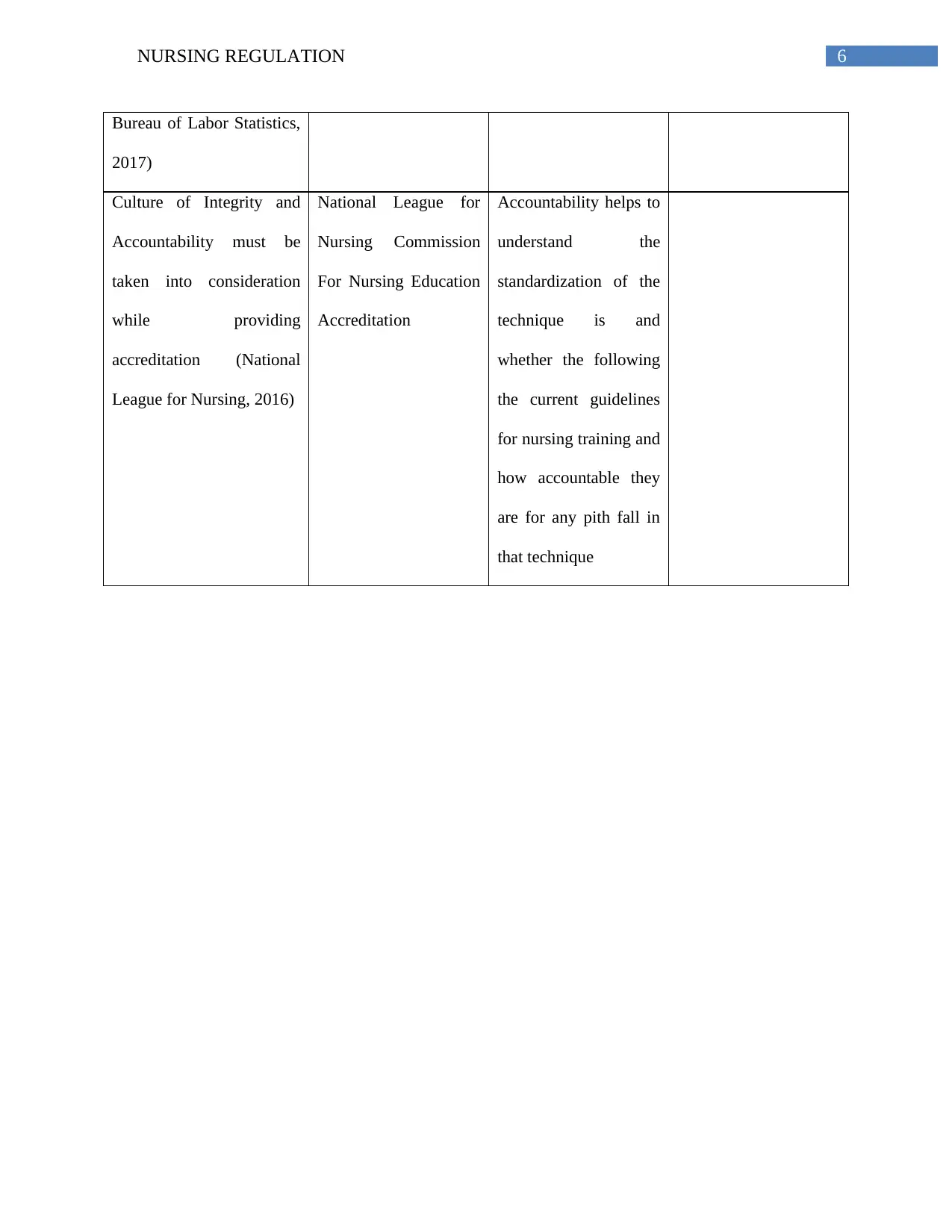
6NURSING REGULATION
Bureau of Labor Statistics,
2017)
Culture of Integrity and
Accountability must be
taken into consideration
while providing
accreditation (National
League for Nursing, 2016)
National League for
Nursing Commission
For Nursing Education
Accreditation
Accountability helps to
understand the
standardization of the
technique is and
whether the following
the current guidelines
for nursing training and
how accountable they
are for any pith fall in
that technique
Bureau of Labor Statistics,
2017)
Culture of Integrity and
Accountability must be
taken into consideration
while providing
accreditation (National
League for Nursing, 2016)
National League for
Nursing Commission
For Nursing Education
Accreditation
Accountability helps to
understand the
standardization of the
technique is and
whether the following
the current guidelines
for nursing training and
how accountable they
are for any pith fall in
that technique
Paraphrase This Document
Need a fresh take? Get an instant paraphrase of this document with our AI Paraphraser
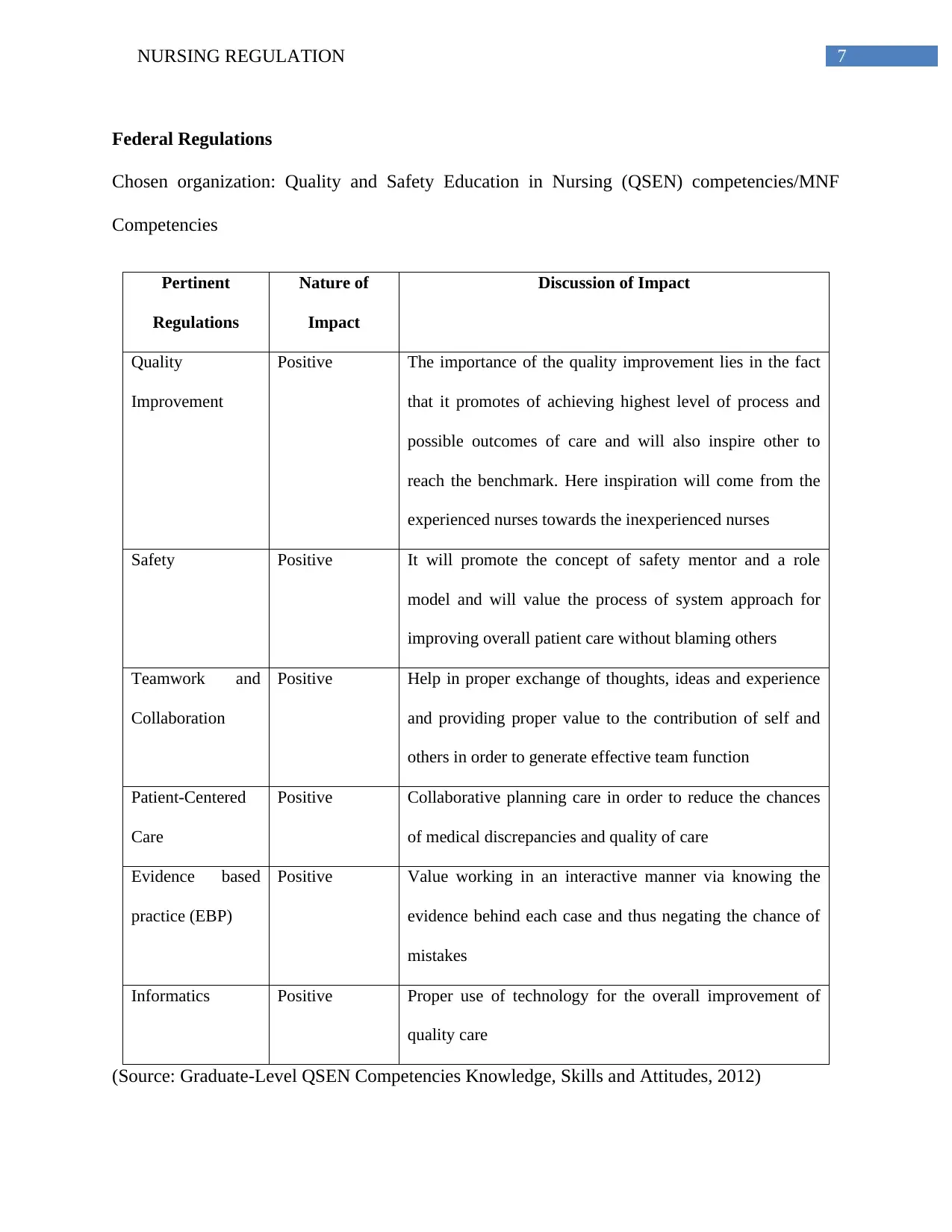
7NURSING REGULATION
Federal Regulations
Chosen organization: Quality and Safety Education in Nursing (QSEN) competencies/MNF
Competencies
Pertinent
Regulations
Nature of
Impact
Discussion of Impact
Quality
Improvement
Positive The importance of the quality improvement lies in the fact
that it promotes of achieving highest level of process and
possible outcomes of care and will also inspire other to
reach the benchmark. Here inspiration will come from the
experienced nurses towards the inexperienced nurses
Safety Positive It will promote the concept of safety mentor and a role
model and will value the process of system approach for
improving overall patient care without blaming others
Teamwork and
Collaboration
Positive Help in proper exchange of thoughts, ideas and experience
and providing proper value to the contribution of self and
others in order to generate effective team function
Patient-Centered
Care
Positive Collaborative planning care in order to reduce the chances
of medical discrepancies and quality of care
Evidence based
practice (EBP)
Positive Value working in an interactive manner via knowing the
evidence behind each case and thus negating the chance of
mistakes
Informatics Positive Proper use of technology for the overall improvement of
quality care
(Source: Graduate-Level QSEN Competencies Knowledge, Skills and Attitudes, 2012)
Federal Regulations
Chosen organization: Quality and Safety Education in Nursing (QSEN) competencies/MNF
Competencies
Pertinent
Regulations
Nature of
Impact
Discussion of Impact
Quality
Improvement
Positive The importance of the quality improvement lies in the fact
that it promotes of achieving highest level of process and
possible outcomes of care and will also inspire other to
reach the benchmark. Here inspiration will come from the
experienced nurses towards the inexperienced nurses
Safety Positive It will promote the concept of safety mentor and a role
model and will value the process of system approach for
improving overall patient care without blaming others
Teamwork and
Collaboration
Positive Help in proper exchange of thoughts, ideas and experience
and providing proper value to the contribution of self and
others in order to generate effective team function
Patient-Centered
Care
Positive Collaborative planning care in order to reduce the chances
of medical discrepancies and quality of care
Evidence based
practice (EBP)
Positive Value working in an interactive manner via knowing the
evidence behind each case and thus negating the chance of
mistakes
Informatics Positive Proper use of technology for the overall improvement of
quality care
(Source: Graduate-Level QSEN Competencies Knowledge, Skills and Attitudes, 2012)
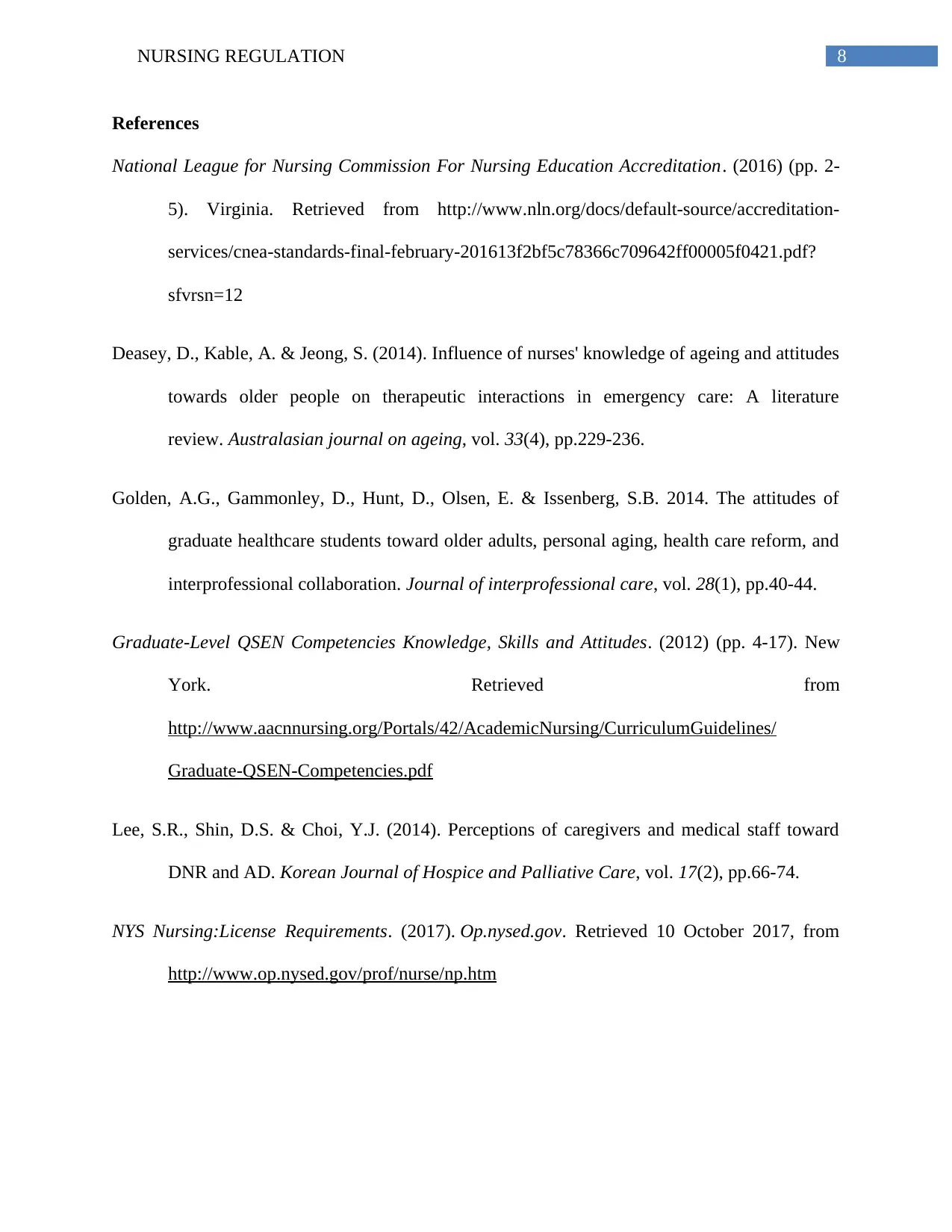
8NURSING REGULATION
References
National League for Nursing Commission For Nursing Education Accreditation. (2016) (pp. 2-
5). Virginia. Retrieved from http://www.nln.org/docs/default-source/accreditation-
services/cnea-standards-final-february-201613f2bf5c78366c709642ff00005f0421.pdf?
sfvrsn=12
Deasey, D., Kable, A. & Jeong, S. (2014). Influence of nurses' knowledge of ageing and attitudes
towards older people on therapeutic interactions in emergency care: A literature
review. Australasian journal on ageing, vol. 33(4), pp.229-236.
Golden, A.G., Gammonley, D., Hunt, D., Olsen, E. & Issenberg, S.B. 2014. The attitudes of
graduate healthcare students toward older adults, personal aging, health care reform, and
interprofessional collaboration. Journal of interprofessional care, vol. 28(1), pp.40-44.
Graduate-Level QSEN Competencies Knowledge, Skills and Attitudes. (2012) (pp. 4-17). New
York. Retrieved from
http://www.aacnnursing.org/Portals/42/AcademicNursing/CurriculumGuidelines/
Graduate-QSEN-Competencies.pdf
Lee, S.R., Shin, D.S. & Choi, Y.J. (2014). Perceptions of caregivers and medical staff toward
DNR and AD. Korean Journal of Hospice and Palliative Care, vol. 17(2), pp.66-74.
NYS Nursing:License Requirements. (2017). Op.nysed.gov. Retrieved 10 October 2017, from
http://www.op.nysed.gov/prof/nurse/np.htm
References
National League for Nursing Commission For Nursing Education Accreditation. (2016) (pp. 2-
5). Virginia. Retrieved from http://www.nln.org/docs/default-source/accreditation-
services/cnea-standards-final-february-201613f2bf5c78366c709642ff00005f0421.pdf?
sfvrsn=12
Deasey, D., Kable, A. & Jeong, S. (2014). Influence of nurses' knowledge of ageing and attitudes
towards older people on therapeutic interactions in emergency care: A literature
review. Australasian journal on ageing, vol. 33(4), pp.229-236.
Golden, A.G., Gammonley, D., Hunt, D., Olsen, E. & Issenberg, S.B. 2014. The attitudes of
graduate healthcare students toward older adults, personal aging, health care reform, and
interprofessional collaboration. Journal of interprofessional care, vol. 28(1), pp.40-44.
Graduate-Level QSEN Competencies Knowledge, Skills and Attitudes. (2012) (pp. 4-17). New
York. Retrieved from
http://www.aacnnursing.org/Portals/42/AcademicNursing/CurriculumGuidelines/
Graduate-QSEN-Competencies.pdf
Lee, S.R., Shin, D.S. & Choi, Y.J. (2014). Perceptions of caregivers and medical staff toward
DNR and AD. Korean Journal of Hospice and Palliative Care, vol. 17(2), pp.66-74.
NYS Nursing:License Requirements. (2017). Op.nysed.gov. Retrieved 10 October 2017, from
http://www.op.nysed.gov/prof/nurse/np.htm
⊘ This is a preview!⊘
Do you want full access?
Subscribe today to unlock all pages.

Trusted by 1+ million students worldwide
1 out of 9
Related Documents
Your All-in-One AI-Powered Toolkit for Academic Success.
+13062052269
info@desklib.com
Available 24*7 on WhatsApp / Email
![[object Object]](/_next/static/media/star-bottom.7253800d.svg)
Unlock your academic potential
Copyright © 2020–2025 A2Z Services. All Rights Reserved. Developed and managed by ZUCOL.





